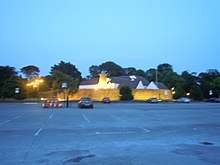Siamsa Tíre
Siamsa Tíre (Irish pronunciation: [ˈʃiəmsˠə ˈtʲiːrʲə], meaning "entertainment of the land") is home to Ireland's National Folk Theatre and is located in Tralee Town Park, Tralee, County Kerry, Ireland.

History and activities
Siamsa, pronounced "Shee-am-sa", comes from the Irish language. The word itself expresses mirth and music, Tíre means ‘of the land’. At the heart of Siamsa Tíre lies a professional repertory company group drawn from the local community but trained in the unique Siamsa style and idiom over a period of ten years. Full-time and community performers integrate and blend into a dedicated and talented team performing a repertoire of productions each summer.
Following the move to its custom built premises in 1991 the company embraced the role of operating an Arts Centre. Now, in addition to its remit as the National Folk Theatre, Siamsa Tíre also hosts a wide variety of events throughout the year. Contemporary theatre, dance, classical music, comedy and literary events feature on a year-round programme, as well as a vibrant visual programme in the dedicated gallery spaces, which also explore the themes of folk culture. Siamsa Tíre also hosts residencies by professional artists and regularly tours the work of the National Folk Theatre.
In recent years, Siamsa Tíre has become increasingly involved in exploring new ways of interpreting folk culture, including a number of multidisciplinary projects incorporating contemporary dance, visual arts and site specific work.
History
The origins of Siamsa Tire date back to 1957 when a young curate, Fr Pat Ahern, was sent to Kerry to establish a new choir in St John's church in Tralee. The success of the choir and the talents of some of the members inspired Pat Ahern to stage a Passion Play entitled, Golgotha, in 1963. This performance met with such acclaim that a celebratory night was organised to acknowledge the performers and organisers. The night concluded with a special presentation of song, dance and music by some of those involved. This too was so warmly received that Pat Ahern and a number of others decided to continue to explore further possibilities for the informal group. They decided to call themselves, Siamsóirí na Ríochta.
A core impetus for the group was the preservation of some of the traditions in music, song and dance in North Kerry that were in danger of disappearing. Chief among these was the ‘Munnix’ style of dancing as taught by the travelling dance master, Jeremiah Molyneaux, or Jerry Munnix as he was known. Many of the pieces included in the initial presentations focused on the Amhráin Saothar or work song which accompanied many of the traditional occupations and tasks in rural Ireland. Threshing, tending to animals, scything, churning, cobbling, along with festivals such as Bealtaine and Lughnasa formed the core of these productions.
During these early years, Siamsóirí na Ríochta performed in a variety of venues in Ireland (including the Abbey Theatre) and abroad and were also invited to perform on a number of Raidio Telefís Éireann productions. In 1968, Michael Maye, a Bord Fáilte representative in Tralee, suggested that the group stage a season of productions during the summer. This was to be Siamsa Tíre's first Summer Season.
Pat Ahern prepared a plan to foster the development of Irish folk culture in 1972 and in the ensuing years he proceeded to implement it. With the formation of Siamsa Tíre Teo in 1974, Pat Ahern was appointed Artistic Director, a position he held until his retirement in 1998.
A vital element of Pat Ahern's plan was the fostering of traditional Irish folk culture in a series of Tithe Siamsa or Folk Academies located in strategic, tradition-rich parts of rural Ireland. The first of these was built in Finuge in North Kerry in 1974 and the second some years later in Carraig in the Chorcha Dhuibhne Gaeltacht. Here, training in music, dance, song and movement continues to be delivered to selected students over a period of three years, free of charge. Those students who show significant promise then graduate to an advanced class in Siamsa Tíre in Tralee, and from there to the Community Cast of the company.
The other key individual in the development of Siamsa Tíre was Martin Whelan. Martin initially became involved in a voluntary capacity when the Teach Siamsa in Finuge was being built. His energy and commitment to this development lead him to take a more full-time role in the organisation and in 1974, he was appointed manager of Siamsa Tíre, a position he retained until his untimely death in 2002. At the time of his passing, Martin Whelan had become one of the best known and best loved arts administrators in the country.
Martin, along with Pat Ahern and architect, Patrick O’Sullivan were instrumental in the building of the current theatre and arts centre in Tralee, travelling as far afield as the United States to study other arts facilities. The new theatre and arts centre was officially opened in 1991. Prior to this, Siamsa Tíre had a number of temporary homes, including the Ashe Memorial Hall and the old Theatre Royal in Tralee. The current theatre and arts centre is a testament to the vision of all three men and is still widely regarded as one of the best arts facilities in the country.
Siamsa Tíre continues to play a central role in Irish cultural life, regionally and nationally. Tours abroad over the past 40 years have also contributed to a growing international reputation for the company. Siamsa Tíre continues to place a strong emphasis on development, working with visiting choreographers such as :Cindy Cummings, Catherine Young, Stacey Printz, Mary-Ellen McCarthy and Directors Jo Mangan, Brian Brady, John Sheehan and writer Michael Harding.
“There is a sense in which we do not own our culture, we are only trustees. The treasure is only on loan and we must take it, refurbish it in the light of our experience and hand it on." Fr Pat Ahern.